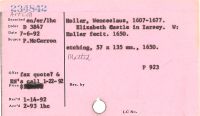Accession slips: Difference between revisions
(Created article) |
(Added "Goldenrod") |
||
| (4 intermediate revisions by the same user not shown) | |||
| Line 1: | Line 1: | ||
From 1948 (the introduction of the six-digit [[Accession numbers|accession number]] system) until 1996 (the introduction of [[Voyager ILS|Voyager]], the Folger's first Integrated Library System) new acquisitions were accessioned into the collection on | From 1948 (the introduction of the six-digit [[Accession numbers|accession number]] system) until 1996 (the introduction of [[Voyager ILS|Voyager]], the Folger's first Integrated Library System) new acquisitions were accessioned into the collection on multi-part carbons known in-house as Accession Slips, or "Acc slips" (sometimes known as "flimsies" in other libraries). | ||
[[File:AccSlip.jpg|200px|thumb|right|Example of an Accession slip]] | |||
[[File:Yellow-slips.jpg|200px|thumb|right|Yellow slips (staff alphabetical)]] | |||
[[File:White-slips.jpg|200px|thumb|right|White slips (staff numeric)]] | |||
[[File:Pink-slips.jpg|200px|thumb|right|Pink slips (public alphabetical)]] | |||
[[File:Green-slips.jpg|200px|thumb|right|Green slips (public chronological)]] | |||
The main portion of the accession slip contains basic bibliographic information about the item (typically Author, Title, and Imprint; sometimes also some copy-specific information). The upper left corner contains the stamped accession number. The left margin has pre-printed labels for administrative information: | The main portion of the accession slip contains basic bibliographic information about the item (typically Author, Title, and Imprint; sometimes also some copy-specific information). The upper left corner contains the stamped accession number. The left margin has pre-printed labels for administrative information: | ||
# Searched (the initials of the staff member who searched to see if the library already had a copy of the book being considered) | # "Searched" (the initials of the staff member who searched to see if the library already had a copy of the book being considered and if so, whether the copy on offer was special enough to acquire anyway, or if not, whether the book on offer fit well enough into the Folger's collecting scope to be worth the price) | ||
# Order (the Purchase Order number, assigned when the order was placed; to keep PO numbers easier to read at a glance, they consist of a capital letter followed by a serial number, and advance to the next letter after four digits, e.g. C 9999 was followed by D 1) | # "Order" (the Purchase Order number, assigned when the order was placed; to keep PO numbers easier to read at a glance, they consist of a capital letter followed by a serial number, and they advance to the next letter after four digits, e.g. C 9999 was followed by D 1) | ||
# Date (mm-dd-yy for the date the order was placed with the vendor) | # "Date" (mm-dd-yy for the date the order was placed with the vendor) | ||
# Source (short-form of the vendor's name, usually an antiquarian bookseller) | # "Source" (short-form of the vendor's name, usually an antiquarian bookseller) | ||
# Offer (typically a reference to the vendor's catalog and item number, e.g., "Cat.63:139", or a reference to the date of a direct quote from the vendor, e.g., "q 6-28-83") | # "Offer" (typically a reference to the vendor's catalog and item number, e.g., "Cat.63:139", or a reference to the date of a direct quote from the vendor, e.g., "q 6-28-83") | ||
# Price (cost in local currency, excluding shipping; sometimes with the USD equivalent at the time. Price only remains visible on the top | # "Price" (cost in local currency, excluding shipping; sometimes with the USD equivalent at the time. Price only remains visible on the top two copies; it's blacked out by hand on the copies that get filed in the public card catalog) | ||
# Red'd (dd-mm-yy the item was received, unpacked, and verified | # "Red'd" (dd-mm-yy the item was received, unpacked, and verified as being the correct item; sometimes also the initials of the staff member doing the receiving) | ||
# Acc'd (dd-mm-yy the item was accessioned into the collection by having been paid for, and assigned a six-digit serial number that got stamped on each of the four parts of the accession slip, stamped on a paper flag tucked inside the book, and written in pencil at the back of the book after the letter "F") | # "Acc'd" (dd-mm-yy the item was accessioned into the collection by having been paid for, and assigned a six-digit serial number that got stamped on each of the four parts of the accession slip, stamped on a paper flag tucked inside the book, and written in pencil at the back of the book after the letter "F"; sometimes also the initials of the staff member doing the accessioning) | ||
After accessioning was complete, the | After accessioning was complete, the multi-part carbons were split and filed separately. | ||
# Yellow: filed alphabetically in the Acquisitions Office's "Alpha" drawers (typically by Author, but by Title in the case of anonymous works). Yellow slips are kept indefinitely as part of the institutional archive. | # Yellow: filed alphabetically in the Acquisitions Office's "Alpha" drawers (typically by Author, but by Title in the case of anonymous works). Yellow slips are kept indefinitely as part of the institutional archive. | ||
# White: filed numerically in the Acquisitions Office's "Numeric" drawers. White slips are kept indefinitely as part of the institutional archive. | # White: filed numerically in the Acquisitions Office's "Numeric" drawers. White slips are kept indefinitely as part of the institutional archive. | ||
# Pink: filed alphabetically in the Public Card Catalog (typically by Author, but by Title in the case of anonymous works). Before the Public Card Catalog was closed in 1996, each book's pink slip remained as a place-holder until the book had been fully cataloged and set of catalog cards typed up (a "Main Entry" card with full information about the book, typically filed alphabetically by Author, but by Title in the case of anonymous works; and "Added Entry" cards with brief information cross-reference to the Main Entry card for each of the other ways someone might try to find the book: other forms of the title, various subjects, various genres, date of publication, place of publication, printer's name, former owner's name, etc.). The pink slip was removed and discarded when typed cards got filed. The pink slips that remain today document the extent of the cataloging backlog as of 1996. Many of these books have now been fully cataloged; others only have a "preliminary record" created in 2020 when the green slips (see below) were transcribed into online records. | # Pink: filed alphabetically in the Public Card Catalog (typically by Author, but by Title in the case of anonymous works). Before the Public Card Catalog was closed in 1996, each book's pink slip remained as a place-holder until the book had been fully cataloged and set of catalog cards typed up (a "Main Entry" card with full information about the book, typically filed alphabetically by Author, but by Title in the case of anonymous works; and "Added Entry" cards with brief information cross-reference to the Main Entry card for each of the other ways someone might try to find the book: other forms of the title, various subjects, various genres, date of publication, place of publication, printer's name, former owner's name, etc.). The pink slip was removed and discarded when typed cards got filed. The pink slips that remain today document the extent of the cataloging backlog as of 1996. Many of these books have now been fully cataloged; others only have a "preliminary record" created in 2020 when the green slips (see below) were transcribed into online records. | ||
# Green: filed chronologically by year of publication (and alphabetically within each year) in four series: STC Imprints (printed texts in English and/or printed in the British Isles from 1475-1640), Wing Imprints (printed texts in English and/or printed in the British Isles from 1641-1700), 18th-century Imprints (printed texts in English and/or printed in the British Isles from 1701-1800), and Continental Imprints (all other printed texts from before 1801). The green slip was removed and replaced by a Chronological Added Entry card after the book was fully cataloged. Remaining green slips represent the cataloging backlog at the time the online catalog was introduced in 1997. In 2020, all green slips were transcribed to create preliminary records in the online catalog for any title that had not been fully cataloged in the meantime. Inevitably, this sometimes means there are duplicate records for the same book: a full catalog record created between 1997 and 2020, plus the preliminary record created from the green slip. Please report any duplicate records to catalog@folger.edu. Folger policy calls for the record with the lower record ID number to be kept, so choose that URL if you need to bookmark a record for later. | # Green: filed chronologically by year of publication (and alphabetically within each year) in four series: STC Imprints (printed texts in English and/or printed in the British Isles from 1475-1640), Wing Imprints (printed texts in English and/or printed in the British Isles from 1641-1700), 18th-century Imprints (printed texts in English and/or printed in the British Isles from 1701-1800), and Continental Imprints (all other printed texts from before 1801). The green slip was removed and replaced by a Chronological Added Entry card after the book was fully cataloged. Remaining green slips represent the cataloging backlog at the time the online catalog was introduced in 1997. In 2020, all green slips were transcribed to create preliminary records in the online catalog for any title that had not been fully cataloged in the meantime. Inevitably, this sometimes means there are duplicate records for the same book: a full catalog record created between 1997 and 2020, plus the preliminary record created from the green slip. Please report any duplicate records to catalog@folger.edu. Folger policy calls for the record with the lower record ID number to be kept, so choose that URL if you need to bookmark a record for later. | ||
# Goldenrod: not sure about these, since they're not listed in the acquisitions procedures document that was used as the basis for this article. They might have been instead of a pink copy in some batches of slips? Maybe some batches of slips had five-part carbons, and the Goldenrod slip was meant to be kept with the book until it was fully cataloged? | |||
Latest revision as of 10:20, 6 May 2024
From 1948 (the introduction of the six-digit accession number system) until 1996 (the introduction of Voyager, the Folger's first Integrated Library System) new acquisitions were accessioned into the collection on multi-part carbons known in-house as Accession Slips, or "Acc slips" (sometimes known as "flimsies" in other libraries).
The main portion of the accession slip contains basic bibliographic information about the item (typically Author, Title, and Imprint; sometimes also some copy-specific information). The upper left corner contains the stamped accession number. The left margin has pre-printed labels for administrative information:
- "Searched" (the initials of the staff member who searched to see if the library already had a copy of the book being considered and if so, whether the copy on offer was special enough to acquire anyway, or if not, whether the book on offer fit well enough into the Folger's collecting scope to be worth the price)
- "Order" (the Purchase Order number, assigned when the order was placed; to keep PO numbers easier to read at a glance, they consist of a capital letter followed by a serial number, and they advance to the next letter after four digits, e.g. C 9999 was followed by D 1)
- "Date" (mm-dd-yy for the date the order was placed with the vendor)
- "Source" (short-form of the vendor's name, usually an antiquarian bookseller)
- "Offer" (typically a reference to the vendor's catalog and item number, e.g., "Cat.63:139", or a reference to the date of a direct quote from the vendor, e.g., "q 6-28-83")
- "Price" (cost in local currency, excluding shipping; sometimes with the USD equivalent at the time. Price only remains visible on the top two copies; it's blacked out by hand on the copies that get filed in the public card catalog)
- "Red'd" (dd-mm-yy the item was received, unpacked, and verified as being the correct item; sometimes also the initials of the staff member doing the receiving)
- "Acc'd" (dd-mm-yy the item was accessioned into the collection by having been paid for, and assigned a six-digit serial number that got stamped on each of the four parts of the accession slip, stamped on a paper flag tucked inside the book, and written in pencil at the back of the book after the letter "F"; sometimes also the initials of the staff member doing the accessioning)
After accessioning was complete, the multi-part carbons were split and filed separately.
- Yellow: filed alphabetically in the Acquisitions Office's "Alpha" drawers (typically by Author, but by Title in the case of anonymous works). Yellow slips are kept indefinitely as part of the institutional archive.
- White: filed numerically in the Acquisitions Office's "Numeric" drawers. White slips are kept indefinitely as part of the institutional archive.
- Pink: filed alphabetically in the Public Card Catalog (typically by Author, but by Title in the case of anonymous works). Before the Public Card Catalog was closed in 1996, each book's pink slip remained as a place-holder until the book had been fully cataloged and set of catalog cards typed up (a "Main Entry" card with full information about the book, typically filed alphabetically by Author, but by Title in the case of anonymous works; and "Added Entry" cards with brief information cross-reference to the Main Entry card for each of the other ways someone might try to find the book: other forms of the title, various subjects, various genres, date of publication, place of publication, printer's name, former owner's name, etc.). The pink slip was removed and discarded when typed cards got filed. The pink slips that remain today document the extent of the cataloging backlog as of 1996. Many of these books have now been fully cataloged; others only have a "preliminary record" created in 2020 when the green slips (see below) were transcribed into online records.
- Green: filed chronologically by year of publication (and alphabetically within each year) in four series: STC Imprints (printed texts in English and/or printed in the British Isles from 1475-1640), Wing Imprints (printed texts in English and/or printed in the British Isles from 1641-1700), 18th-century Imprints (printed texts in English and/or printed in the British Isles from 1701-1800), and Continental Imprints (all other printed texts from before 1801). The green slip was removed and replaced by a Chronological Added Entry card after the book was fully cataloged. Remaining green slips represent the cataloging backlog at the time the online catalog was introduced in 1997. In 2020, all green slips were transcribed to create preliminary records in the online catalog for any title that had not been fully cataloged in the meantime. Inevitably, this sometimes means there are duplicate records for the same book: a full catalog record created between 1997 and 2020, plus the preliminary record created from the green slip. Please report any duplicate records to catalog@folger.edu. Folger policy calls for the record with the lower record ID number to be kept, so choose that URL if you need to bookmark a record for later.
- Goldenrod: not sure about these, since they're not listed in the acquisitions procedures document that was used as the basis for this article. They might have been instead of a pink copy in some batches of slips? Maybe some batches of slips had five-part carbons, and the Goldenrod slip was meant to be kept with the book until it was fully cataloged?




